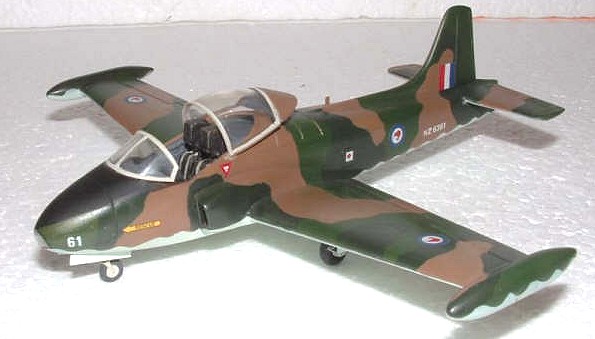
| KIT #: | PK- |
| PRICE: | $ |
| DECALS: | Two options |
| REVIEWER: | Mark Fordham |
| NOTES: |

| HISTORY |
The Strikemaster Mk.88
was ordered by the RNZAF in 1970 as a Vampire replacement. The first 10 of
the 16 aircraft (NZ6361-6376) arrived from October 1972, with the remainder
in 1975. The first aircraft to operate in New Zealand was
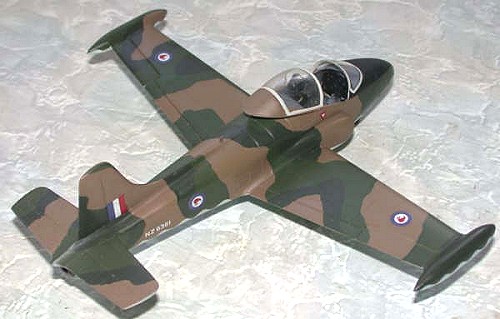 NZ6361, which was
flown by F/L G.R. Lloyd and S/L J.S. Hosie on October 28, 1972, three weeks
prior to the official handover. Two of the aircraft (NZ6364 and NZ6365)
were shown at Farnborough prior to delivery. Aircraft from the second batch
were also displayed at Paris. The Strikemasters were used in a
trainer/strike conversion role and assigned to 14 Squadron based at Ohakea.
Initial training was completed on the Harvard at Wigram before pilots moved
up to the Strikemaster for jet conversion. The aircraft was fitted with a
full instrument layout to facilitate easy conversion to the A-4K. From 1976
the Airtrainer was introduced for initial training, with the Harvard being
retired in 1977. At the same time an advanced training phase and strike
conversion was introduced on the Strikemaster (the second batch of Mk.88's
having been procured in 1975 to provide for this). The aircraft were
periodically seen around the country when deployed to a variety of
provincial airports on 'Falcons Roost' exercises.
NZ6361, which was
flown by F/L G.R. Lloyd and S/L J.S. Hosie on October 28, 1972, three weeks
prior to the official handover. Two of the aircraft (NZ6364 and NZ6365)
were shown at Farnborough prior to delivery. Aircraft from the second batch
were also displayed at Paris. The Strikemasters were used in a
trainer/strike conversion role and assigned to 14 Squadron based at Ohakea.
Initial training was completed on the Harvard at Wigram before pilots moved
up to the Strikemaster for jet conversion. The aircraft was fitted with a
full instrument layout to facilitate easy conversion to the A-4K. From 1976
the Airtrainer was introduced for initial training, with the Harvard being
retired in 1977. At the same time an advanced training phase and strike
conversion was introduced on the Strikemaster (the second batch of Mk.88's
having been procured in 1975 to provide for this). The aircraft were
periodically seen around the country when deployed to a variety of
provincial airports on 'Falcons Roost' exercises.
(history from Phillip Treweek’s excellent , kiwiaircraftimages.com site)
| THE KIT |
The Strikemaster is a typical 2 colour Matchbox kit, with Basic Detailing, Spartan interior, almost toy-like wheels and deep trench panel lines, with all the “faults” it still is the best model of a Strikemaster in 1/72nd scale.
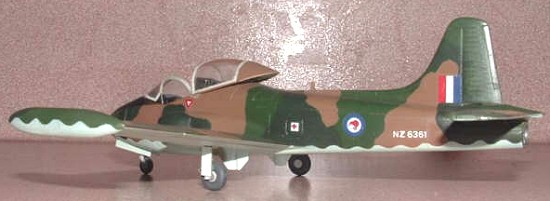 By today standard
these models a crude but for those of us that cant be bothered with shake
and bake type kits then these sort of kits make for interesting modelling.
By today standard
these models a crude but for those of us that cant be bothered with shake
and bake type kits then these sort of kits make for interesting modelling.
Two Decal options are included with the Kit, the RNZAF and the Royal Saudi Air force, The only weapons included with the kit are some stupid looking rockets that I binned. Wheels and undercarriage are typical Matchbox, very strong but a little on the crude side.
Why I really wanted to do this particular model is because it fills one of the last gaps in my RNZAF collection and the bonus was that one of the decal options for the Matchbox kit was the inclusion of Kiwi markings, yay!
| CONSTRUCTION |
Construction of the Bluntie started with the cockpit floor and as the Matchbox kit is a little lacking in detail I decided to add a couple of my home cast side panels to give it the impression of business. The seats that came with the kit a the generic Fruitbat Mk 7 ejector seats fitted to every Matchbox, Frog, Airfix and Starfix Aircraft since 1942, needless to say they were a tad …… generic! I found a couple of nice looking white metal seats hiding away in a Aeroclub MB 339 kit that a chap sent me a year or two ago so I borrowed them and made a couple of lead copies of them.
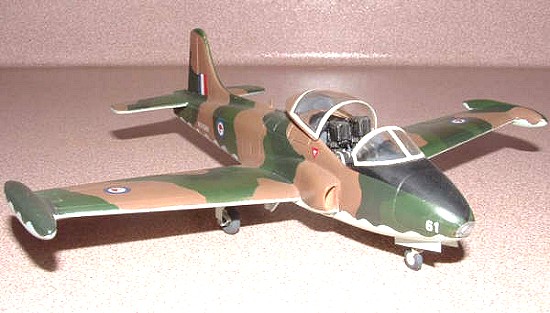 To show off all that
wonderful new detail (not) I removed the rear cockpit molded into the
fuselage and displayed the canopy open, cutting the canopy in half was a
nerve racking job as I knew if I broke it I wouldn’t be able to find a new
one easily; thankfully I didn’t screw it up too much.
To show off all that
wonderful new detail (not) I removed the rear cockpit molded into the
fuselage and displayed the canopy open, cutting the canopy in half was a
nerve racking job as I knew if I broke it I wouldn’t be able to find a new
one easily; thankfully I didn’t screw it up too much.
With the cockpit now suitably busy I closed up the fuselage and sanded the seams down, no filler was needed just a quick wipe over with some 1000 grit. Construction of the wings was straightforward but I added a few scribed panel lines as there was no detail at all on the wings, the trench digger must have been sick that day.
The major components of the Airframe came together in about an hour and a half with a very good fit and all the pieces apart from the intakes, they needed a little bit of filling and sanding to sit right.
One modification that I decided to make that wasn’t included in the kit was to smash mold a clear landing light cover and scratchbuild a lens in behind it, this is a prominent feature of the Bluntie and something overlooked by Matchbox.
| COLORS & MARKINGS |
With the Airframe complete is was off to the paint shop for some colour. I
had from day one wanted to do the early Vietnam type three colour camo
pattern not the later Gray/Green Scheme. So using the instructions as a
guide masked and sprayed the three colour pattern on the upper surfaces
first. 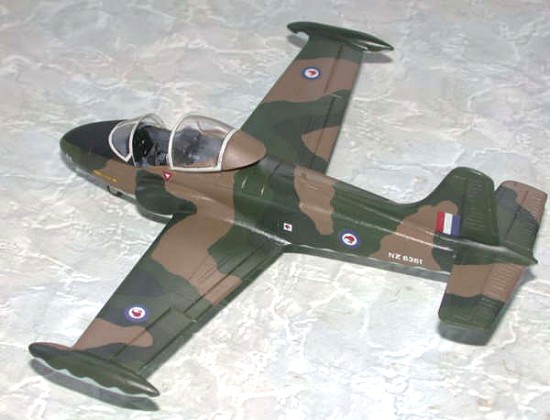
Once all the painted was done I then masked and sprayed the underside blue that was custom mixed. Now there’s a gap of almost a year from building this model to writing the review so stuffed if I can remember the mix!
With the major painting done I gave the model a couple of coats of Future as the paints I had used were matt based then it was time for decals.
Ah Matchbox decals, Love em or Hate em, the biggest problem with mine was the fact that the white was Camel Nicotine white. So the first thing I had to do was put the model on hold for a couple of weeks while our ozone depleted sunlight bleached the brown out of the decals.
Now armed with white roundels again I started applying the markings, to my relief they came off the backing paper with no problems as very old Matchbox decals has tendency to stick for good on the paper. A couple of drops of my home made decal softener and they sucked straight down as good as aftermarket ones and with the addition of some thinly sliced decals around the canopy my Bluntie was done.
| CONCLUSIONS |
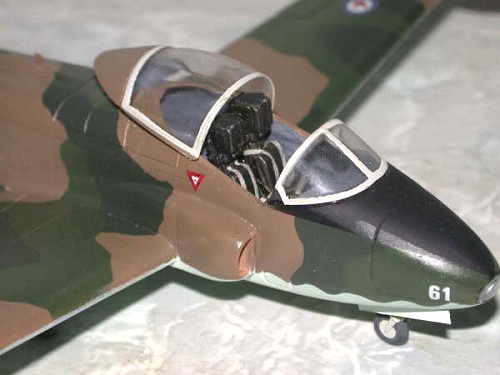 If you have built
Matchbox kits before you will know what to expect, they usually go together
with a minimum of fuss, are a bit basic in detail but make up into good
looking models with the replacement of things like interiors and wheels,
they also did a lot of interesting subjects that still are not done by
today “wunder” kit manufacturers.
If you have built
Matchbox kits before you will know what to expect, they usually go together
with a minimum of fuss, are a bit basic in detail but make up into good
looking models with the replacement of things like interiors and wheels,
they also did a lot of interesting subjects that still are not done by
today “wunder” kit manufacturers.
Sadly now that New Zealand really doesn’t has an Airforce anymore (C-130’s and 757’s not combat aircraft) I’m fast running out of RNZAF aircraft to do.
My thanks to the chap that sent me this model from Canada, I lost my Thank you list in a computer crash at the beginning of the year but you know who you are.
Footnote: the Aircraft depicted in the Matchbox decals NZ 6361 (c/n 301, ex G27-197) was registered as VH-ZEP and last reported at Essendon in Melbourne Vic, Australia
August 2005
| REFERENCES |
Kiwiaircraftimages.com
Aircraft of NZ Handbook.
Copyright ModelingMadness.com
If you would like your product reviewed fairly and fairly quickly, please contact the editor or see other details in the Note to Contributors.